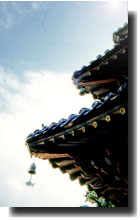 |
 |
 |
 |
 |
Kyongbokkung Palace |
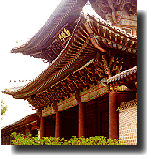 |
Kyongbokkung Palace (Historic Site No. 117) was built in 1395 by King T'aejo of
the Choson Dynasty as the primary residence for the royal family. Among the five palaces in Seoul, it is considered the largest and most beautiful in architectural style. Elegant pavilions such as Kyonghoeru and Hyangwonjong, other refined wooden and stone structures such as Kunjongjon Hall, and the 10-story Stone Pagoda of Kyongch'onsa Temple display a unique charm and beauty of Korean architecture. The National Folk Museum, opened in 1975, is located in the compound, exhi- biting many artifacts that demonstrate traditional Korean ways of life. |

| Division | Adults | Students(Age 19-24) | Remarks |
| Individuals | 700 | 300 | Group : over 30 people |
| Group rates | 550 | 250 | Under 18 : free |

| Division | From | To | Duration | Remarks |
| City bus | City Hall On the opposite side of Sejong Cultural Center |
Nat'l Museum " * * |
10 mins. 5 mins. * * |
No. 8 Nos. 32,6 * * |
City express bus No. 543
Subway Kyongbokkung Line 3, then 5 min. walk
Intercity Bus termianl 82-2-436-2122
Management Office, Tel: 82-2-732-1931
Operating hours : 09:00 - 18:00 (17:00 in winter, closed on Tuesdays)
Facilities : drinking fountains, benches
 Cultural properties
Cultural properties
 Nearby tourist spots
Nearby tourist spots
National Museum, Chogyesa Temple, Sejong Cultural Center, Kyonghuigung Park
 Ch'ongsokkol 82-2-735-5892
Ch'ongsokkol 82-2-735-5892
 |
Ch'angdokkung Palace & Piwon(Secret Garden) |
|
Ch'angdokkung Palace (Historic Site No. 122) was originally constructed in
1405 as a detached palace after Kyongbokkung Palace was constructed. However, since the time of the ninth monarch of the Choson Dynasty, King Songjong, it was used as the main palace. This palace was burned down during the Japanese invasion of 1592 and was rebuilt in 1611 during the reign of Kwanghaegun. |  |
Open
Facilities : drinking fountains, benches, shades, store
Guide Service
 Adults - 2,200, Students/Children - 1,100
Adults - 2,200, Students/Children - 1,100
 Cultural properties
Cultural properties
Nearby tourist spots : Ch'anggyonggung Palace, Chongmyo, Chongmyo park.

| Division | From | To | Duration | Remarks |
| City bus | On the opposite side of Sejong Cultural Center City Hall Cheil Bank HQ. Nat'l Museum |
Ch'angdokkung Ch'angdokkung Ch'angdokkung Ch'angdokkung |
10 mins. 15 mins. 10 mins. 10 mins. |
Nos. 6, 8 Nos. 8, 20 No. 84 Nos. 205, 543, 2 | City express | Cheil Bank HQ. | Ch'angdokkung | 10 mins. | No. 16 |
Subway An-guk Line 3

| Name | Tel. |
| Sangwon Tourist Hotel Hotel Samho Ramada Olympia Hotel Seoul Tourist Hotel Bukak Park Hotel Centural Hotel YMCA Tourist Hotel Eastern Tourist Hotel Sorak Youth Hostel Kumjwa Hotel Komodo Hotel Kogung(Old Palace) Hotel Samho Hotel (Co.) Paekch'on Hotel |
82-2-765-0441 82-2-741-7080~5 82-2-287-6000 82-2-735-9001~5 82-2-395-7100-8 82-2-265-4121~9 82-2-734-6884 82-2-741-7811 82-2-763-9871 82-2-732-7245 82-2-734-1973 82-2-741-3831~5 82-2-741-7080 82-2-742-6671~2 |
 |
Ch'anggyonggung Palace |
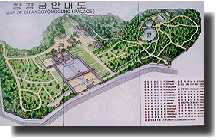 |
Ch'anggyonggung Palace (Historic Site No. 123) was renovated to its original state
in 1987 with the intent to eliminate all vestiges of Japanese colonial rule. This palace was once demoted from Kung (palace) to Won (garden) and became a part of a zoo by the Japanese authorities. Honghwamun is the main gate and Myongjongjon (main hall,oldest of the Choson Dynasty ), |

| Division | Adults | Students | Remarks |
| Individuals | 700 | 300 | Age under 19 : free |
| Group Rates | 550 | 250 | * |

| Type | From | Duration | Remarks |
| City bus | City Hall Kwanghwamun Seoul Station Tongnimmun |
10 mins. 10 mins. 5 mins. 5 mins. |
No. 85 Nos. 6, 8 No. 84 No. 205 |
City express No.205-1
 Cultural properties
Cultural properties
Nearby tourist spots
 |
Chongmyo Royal Shrine |
| Enshrined in Chongmyo are the spirit tablets of Choson period kings and queens
and the tablets of those who were given the title of king or queen posthumously. Within the 190,000 square meter grounds are the Chongjon, or main shrine, the Yongnyongjon, or annex shrine, the Kongshindang (shrines for meritorious subjects), and such auxiliary buildings as the kitchen, the protocol officials' quarters, |
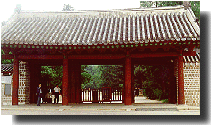 |
 |
Upon its completion he enshrined the ancestral tablets which were brought from Kaesong. At present, 49 tablets are enshrined in 19 rooms of the Chongjon, 33 tablets in 16 rooms of the Yongnyongjon,and 83 tablets in the Kongshindang. Throughout the Choson period, memorial ceremonies were held five times a year for those enshrined in the Chongjon and twice a year for those enshrined in the Yong-nyongjon. |
 Cultural properties
Cultural properties
Nearby tourist spots
Ch'anggyonggung Palace (Historic Site No. 123),
Taehangno (University Street), T'apkol Park,
Unhyongung Palace (Historic Site No. 257)

| Division | Adults | Students/Military (Age 19-24) |
| Individuals | 700 | 300 |
| Group rates | 550 | 250 |

 |
Toksugung Palace |
This palace was originally built as a villa for Prince Wolsan-daegun, an elder
brother of King Songjong. A century later, as all the royal palaces in Seoul had
been burned during the Japanese invasion of 1592, King Sonjo took up a temporary
residence here when he returned to Seoul in 1593.
The palace became known as the "West Palace." The next ruler, Kwanghaegun, held
his coronation here in 1608 and renamed this temporary palace "Kyong-un-gung" in
1611.
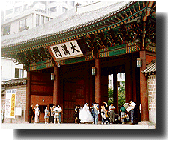 |
He then moved to the rebuilt Ch'angdok-kung Palace in 1615, leaving his step-mother
Queen Inmok-taebi here. When Kwanghaegun was deposed by King Injo in 1623 , the new king held his coronation in this palace. However, he then moved to the Ch'angdokkung Palace and the palace remained a subsidiary for 270 years. In 1897, after his 13-month sojourn in the Russian Legation, King Kojong returned here and used this palace as his primary palace. |
Operating hours : 09:00-18:00, 09:00-16:30 in winter (closed on Mondays)
Cultural properties
Taehanmun Gate, Chunghwajon Hall, Sokchojon Hall,
Hungch'onsa Bell and over 100 other items
Nearby tourist spots

| Division | Adults | Students (Age 19-24) | Remark |
| Individuals | 700 | 300 | Group : over 30 people |
| Group rates | 550 | 250 | Age under 19 : free |
 10 minute walk from City Hall Subway Station on Subway Line 1 or 2
10 minute walk from City Hall Subway Station on Subway Line 1 or 2

Exhibition Hall of Court Relics, Tel: 02-752-0735
|
Cultural Legacy Korean old palaces and museums Korean Traditional Culture |
 |
Shopping in Korea Korean Streets Memo |
e-mail exit@nextel.net
Designed By EXIT SYSTEM